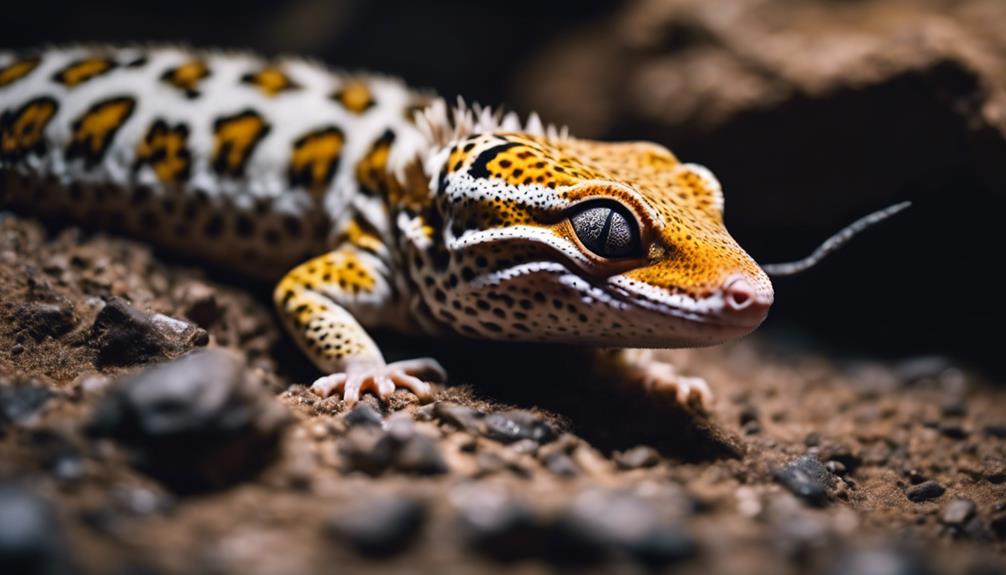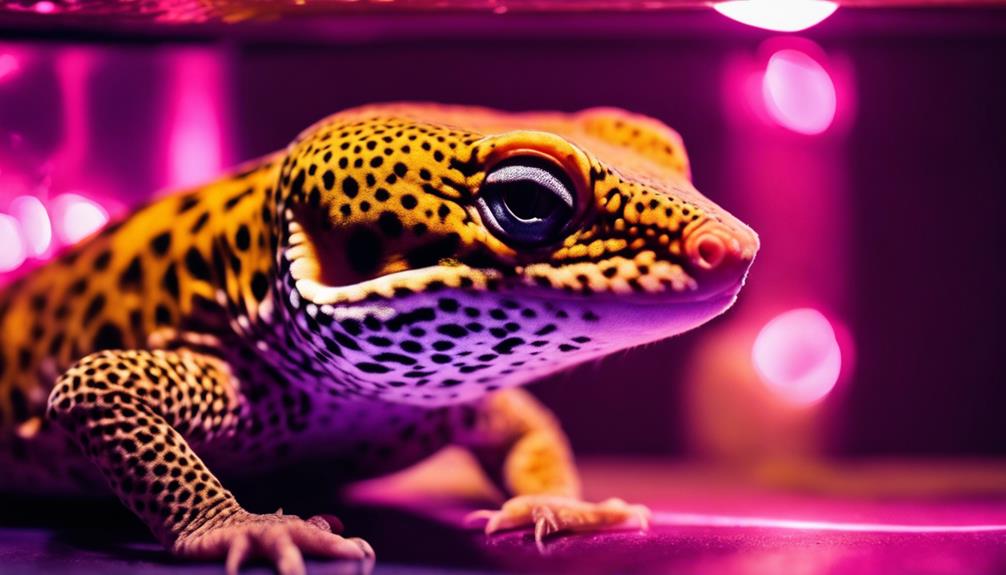If you've ever walked into your room and found your leopard gecko lying motionless in its terrarium, your heart might skip a beat. Is it dead, or is it just hibernating?
The difference between the two can be subtle yet essential. Understanding the signs and knowing how to react can make all the difference in the well-being of your beloved gecko.
Stay tuned to uncover the secrets of deciphering between dormancy and demise, ensuring the best care for your scaly companion.
Key Takeaways
- Recognize signs of brumation: decreased activity, appetite, and seeking cooler areas.
- Differentiate between dormancy and death: monitor breathing, movements, and weight loss.
- Provide proper care during hibernation: maintain temperature, hydration, and nutritional needs.
- Understand appearance changes: weight loss, dull color, lethargy, and cooler skin indicate hibernation.
Hibernation in Leopard Geckos
Leopard geckos exhibit a hibernation-like state known as brumation in response to cold temperatures or reduced light. During brumation, these geckos experience decreased activity levels, reduced appetite, and sluggish movements. This behavior allows leopard geckos to conserve energy by slowing down their metabolism and physiological processes. By entering this state, hibernating leopard geckos can cope with colder temperatures and survive with limited food resources.
Brumation is a natural behavior for leopard geckos and is important for their survival in the wild. When going through brumation, these geckos may appear less active than usual, eat less, and seek out cooler areas in their habitat. This adaptive response helps them endure harsh environmental conditions and conserve crucial energy reserves. Understanding hibernation in leopard geckos is essential for their care and well-being, as it's a fundamental aspect of their biology and natural instincts.
Signs of Brumation in Geckos
When observing a gecko during brumation, you may notice a significant decrease in its activity levels and appetite. Signs of brumation in leopard geckos include:
- Maintain Feeding: Geckos in brumation tend to eat less or stop feeding altogether as their metabolic rate slows down to conserve energy.
- Behavior Changes: They exhibit slower movements, spend more time hiding, and prefer cooler areas within their habitat.
- Temperature Drops: Brumating geckos may seek out cooler spots in their enclosure as they adjust to the decreasing temperatures.
- Energy Conservation: During brumation, leopard geckos prioritize conserving energy by resting more and reducing their overall activity levels.
Monitoring these behaviors and providing appropriate care are essential during this period to maintain the gecko's well-being. By understanding the signs and symptoms of brumation, you can effectively support your leopard gecko through this natural process while maintaining a close eye on their health and condition.
Identifying Deceased Leopard Geckos
Observing a leopard gecko for signs of potential demise involves noting their response to touch or gentle taps, absence of breathing or movement, and any physical changes indicative of health issues. Lack of response to stimuli like touch could be a sign that your leopard gecko has passed away. Additionally, if you observe no breathing or movement over an extended period, it may indicate that your gecko is no longer alive. Physical changes such as extreme weight loss, sunken eyes, and lethargy are also red flags that suggest underlying health issues in leopard geckos.
| Signs of Deceased Leopard Geckos |
|---|
| Lack of response to touch or gentle taps |
| Absence of breathing or movement |
| Extreme weight loss |
| Sunken eyes and lethargy |
Recognizing these signs is essential to provide the appropriate care for your leopard gecko. To determine if your gecko is still alive, closely monitor their breathing patterns and any subtle movements that may signify life.
Changes in Geckos' Appearance During Dormancy
During dormancy, leopard geckos may display changes in their appearance characterized by dull and dry skin due to reduced activity levels. Here are some key indicators to differentiate between hibernation and potential health issues:
- Weight Loss: Geckos in dormancy may experience weight loss as they conserve energy during this period.
- Lack of Vibrancy: A decrease in the vibrancy of their coloration can be observed, making their skin appear duller than usual.
- Lethargy and Decrease in Alertness: Geckos in dormancy tend to be more lethargic, showing a significant decrease in overall alertness and activity levels.
- Cooler Skin: Their skin may feel cooler to the touch as their metabolic rate slows down to adapt to the reduced energy consumption.
Understanding these changes in a gecko's appearance during dormancy is vital in distinguishing normal hibernation from potential health issues. By observing these characteristics closely, you can better care for your leopard gecko during this period of dormancy.
Steps for Caring for Hibernating Geckos
To properly care for hibernating geckos, guarantee their environment maintains a consistent temperature range of 60-70°F. This temperature range supports their natural rest and guarantees their well-being. It's important to provide fresh water for hydration during hibernation, as geckos may not actively seek out water during this time. Additionally, offer appropriately sized live insects to meet their nutritional needs.
Monitor the temperature within the hibernation area regularly to guarantee it stays within the recommended range of 60-70°F. Fluctuations can disrupt the hibernation process and impact the gecko's health.
Proper temperature regulation is essential for the health of hibernating geckos. Any drastic deviations from the optimal range can lead to stress or even illness. By maintaining a consistent temperature, providing access to water, and offering suitable food, you can support your leopard gecko through its hibernation period and help it emerge healthy and well-rested.
Frequently Asked Questions
How Do I Know if My Leopard Gecko Is Hibernating?
To determine if your leopard gecko is hibernating, observe reduced activity levels, decreased appetite, and preference for cooler spots. Check body temperature, uphold habitat warmth, and minimize disturbances. Verify suitable lighting, feeding schedule, and health monitoring.
How Do Leopard Geckos Act When Dying?
When a leopard gecko is dying, signs of distress become evident. Unresponsive behavior, declining health, and lethargic movements mark the terminal stage. Observing its essential signs and providing comfort measures during its last moments is important for palliative care.
Why Did My Leopard Gecko Died Suddenly?
If your leopard gecko died suddenly, common causes could include illnesses, environmental stressors, parasite infestations, improper diet, age-related issues, handling injuries, genetic predispositions, temperature fluctuations, and lack of veterinary care. Careful monitoring and proper care are essential.
What Does Leopard Gecko Brumation Look Like?
During brumation, your leopard gecko may appear lethargic, show reduced appetite, and seek cooler spots. Their metabolism slows, and they may seem unresponsive. Remember, it's a natural behavior; make sure proper care and temperature levels.
Conclusion
So, next time you see your leopard gecko motionless and wonder, 'Is my leopard gecko dead or hibernating?' remember to carefully observe for subtle signs of life.
One gecko owner, Sarah, thought her gecko was deceased, but after monitoring its breathing and slight movements, she realized it was just in brumation.
With proper care and attention, you can guarantee your gecko stays healthy and safe during dormancy.
Stay vigilant and informed!


